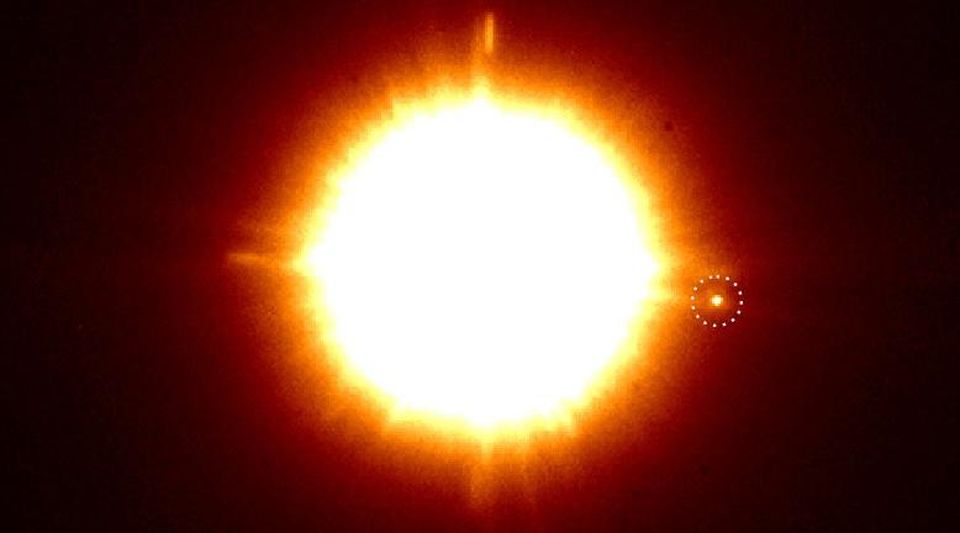 Infrared image of the CS Chameleon CS double star with a recently opened companion (circled in dotted lines). The companion is unique among all discovered by us, and probably has its own dust disk.
Infrared image of the CS Chameleon CS double star with a recently opened companion (circled in dotted lines). The companion is unique among all discovered by us, and probably has its own dust disk.In our universe it is very difficult to grow. In the great gravitational dance of the cosmos, usually the largest and most massive “embryos” of bodies win: they attract more and more of the matter in the vicinity. In the molecular cloud, where stars are formed, it usually turns out that the lumps of the greatest mass grow into stars, and the remaining mass flattens into a disk. Smaller lumps form in this disk, growing into planets, moons and other icy and rocky bodies.
In observing the protoplanetary disk surrounding the young star, there is a key to uncovering the process of forming planets. In 600 light years from us, there is the CS Chameleon star, located in the small southern constellation
Chameleon - a low mass
double star that is in the process of formation. Scientists in search of planets stumbled upon something that they had not seen before. We are still exploring this question, but it may turn out that we are witnessing the birth of a
brown dwarf : an undeveloped star.
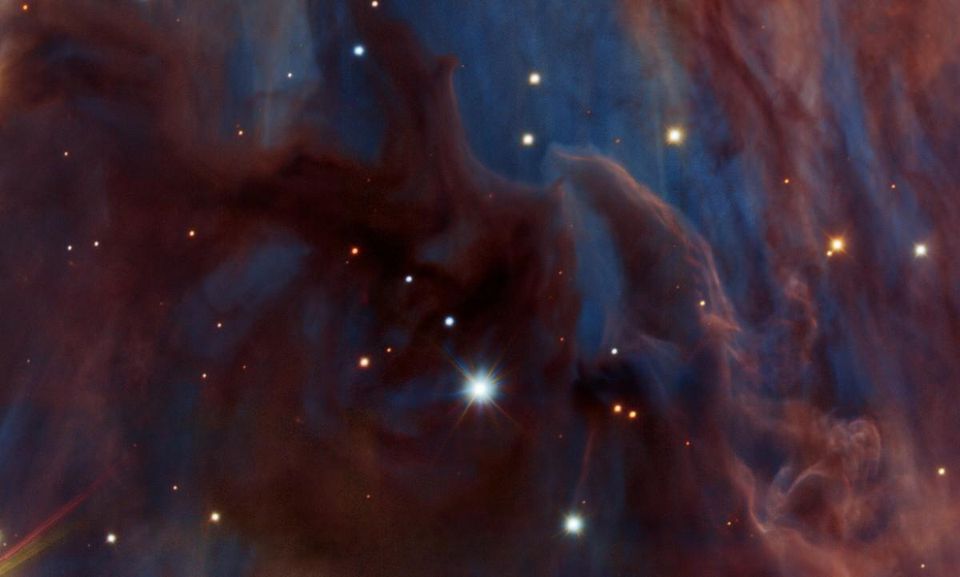 Dust regions that cannot be penetrated by optical telescopes are transparent to infrared telescopes, such as VLT + SPHERE, or HAWK-I of the European Southern Observatory, from which this image was obtained. The infrared range perfectly demonstrates the places of formation of new and future stars, where the density of dust blocking visible light is greatest
Dust regions that cannot be penetrated by optical telescopes are transparent to infrared telescopes, such as VLT + SPHERE, or HAWK-I of the European Southern Observatory, from which this image was obtained. The infrared range perfectly demonstrates the places of formation of new and future stars, where the density of dust blocking visible light is greatestAny molecular cloud of gas of sufficiently large mass has the potential to form a new star. If the cloud cools enough, it begins to shrink, and the greatest initial imperfections attract most of the matter. Chameleon CS is one of such recently born systems, the central region of which consists of a double star, which is in the process of formation. The star is surrounded by a dust disk: exactly what we expected to see around the emerging star system. Using the SPHERE tool from the Very Large Telescope in Chile, scientists measured the system, its disk, and the surrounding matter in detail. They were looking for new planets, but they found something even better than the recently appeared planet.
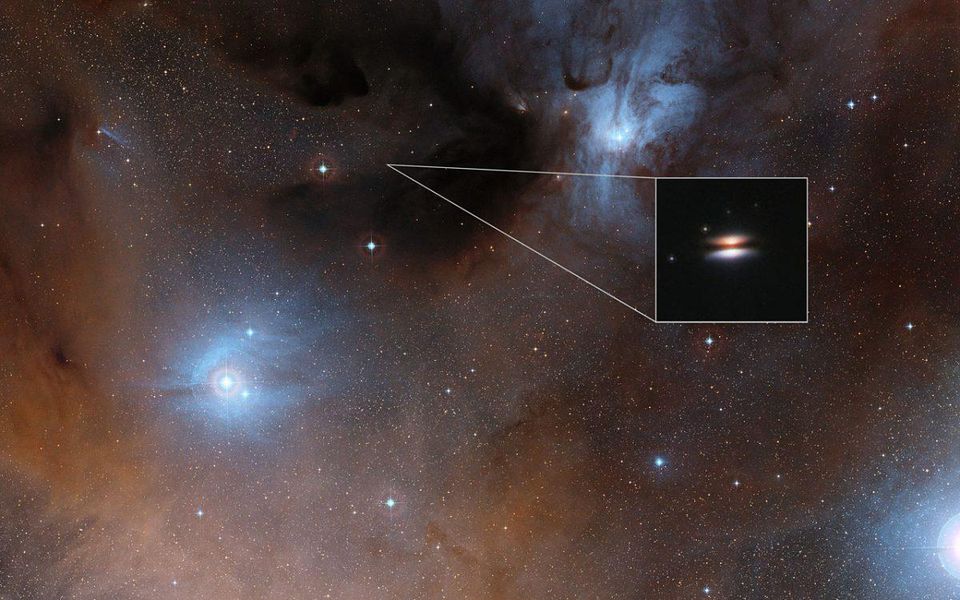 The young star 2MASS J16281370-2431391 is surrounded by a disk of gas and dust, visible almost from the edge: a protoplanetary disk. Since the discovery of 2MASS, we have discovered many such objects, and examined them in more detail.
The young star 2MASS J16281370-2431391 is surrounded by a disk of gas and dust, visible almost from the edge: a protoplanetary disk. Since the discovery of 2MASS, we have discovered many such objects, and examined them in more detail.Unpolarized light usually emanates from a star: the electric and magnetic fields of the light are randomly oriented. When light reflects off something, it becomes polarized. Therefore, starlight has no polarization, and the light reflected from the protoplanetary disk must be polarized. And near this disk in the infrared range, scientists saw another small object. According to the
new work , which should be published in the journal Astronomy & Astrophysics, this object has a brightness just such that it can be either a planet or a brown dwarf of small mass. But the surprise is that the light from this object, which must emit its own unpolarized radiation, was nevertheless polarized.
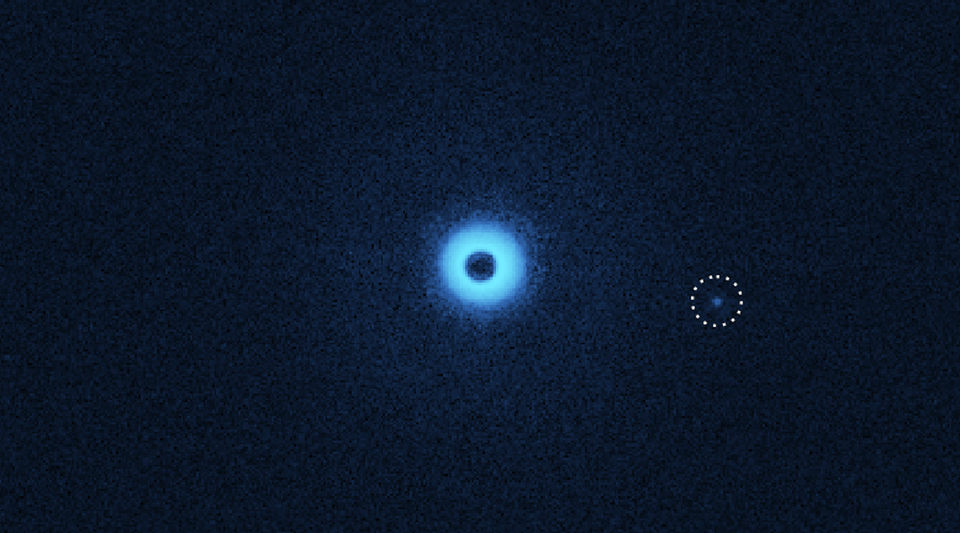 Infrared image of a double star and a newly discovered companion, visible through special polarizing filters that make the dust disk and exoplanets visible. The companion seems to have its own dust disc.
Infrared image of a double star and a newly discovered companion, visible through special polarizing filters that make the dust disk and exoplanets visible. The companion seems to have its own dust disc.If it were a gas giant or a brown dwarf, then the light could be slightly polarized: at the level of about 1%. Astronomers have been looking for similar signals in such systems for a long time, but without success. For the first time a sign of polarization was discovered around such a tiny companion. But the level of polarization was not equal to 1% at all, as one would expect. Instead, it was literally astronomical: an incredible, unprecedented 14%! There are very, very few objects in the universe capable of producing such a polarization, so the team working on this under the control of Christian Ginski needs to be very careful.
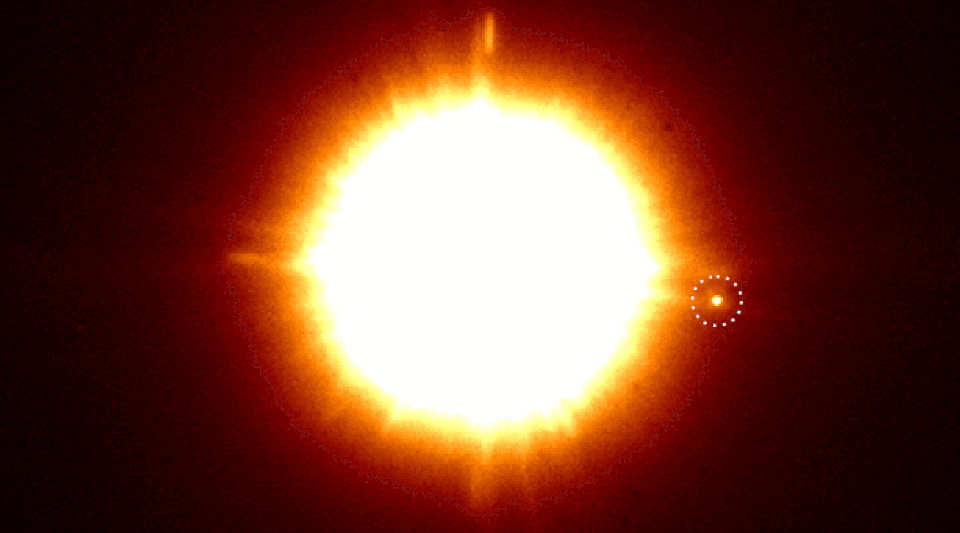 Alternate comparison of infrared and polarized light, where you can see an incredibly high amount of polarization emanating from a companion orbiting in a binary system
Alternate comparison of infrared and polarized light, where you can see an incredibly high amount of polarization emanating from a companion orbiting in a binary systemOne of the ideas that immediately came to mind is that this may not be a real companion of the system, but a distant galaxy emitting light of high polarization. Active galaxies with actively absorbing matter by supermassive black holes digest matter and spit out extremely energy
relativistic jets ; their polarization level can reach that level. But the Ginsky team investigated this possibility, referring to the older data obtained many years ago by the Hubble telescope, to see if you can find in them a sign of having such a companion. And although nothing has been found, the photo from Hubble sometimes comes across annoying
diffraction rays , inherent to him because of his design. And although in the near future we will have a telescope without such features, today we have to use complex processing technologies for their removal. They did just that - and, look, they did find such a companion.
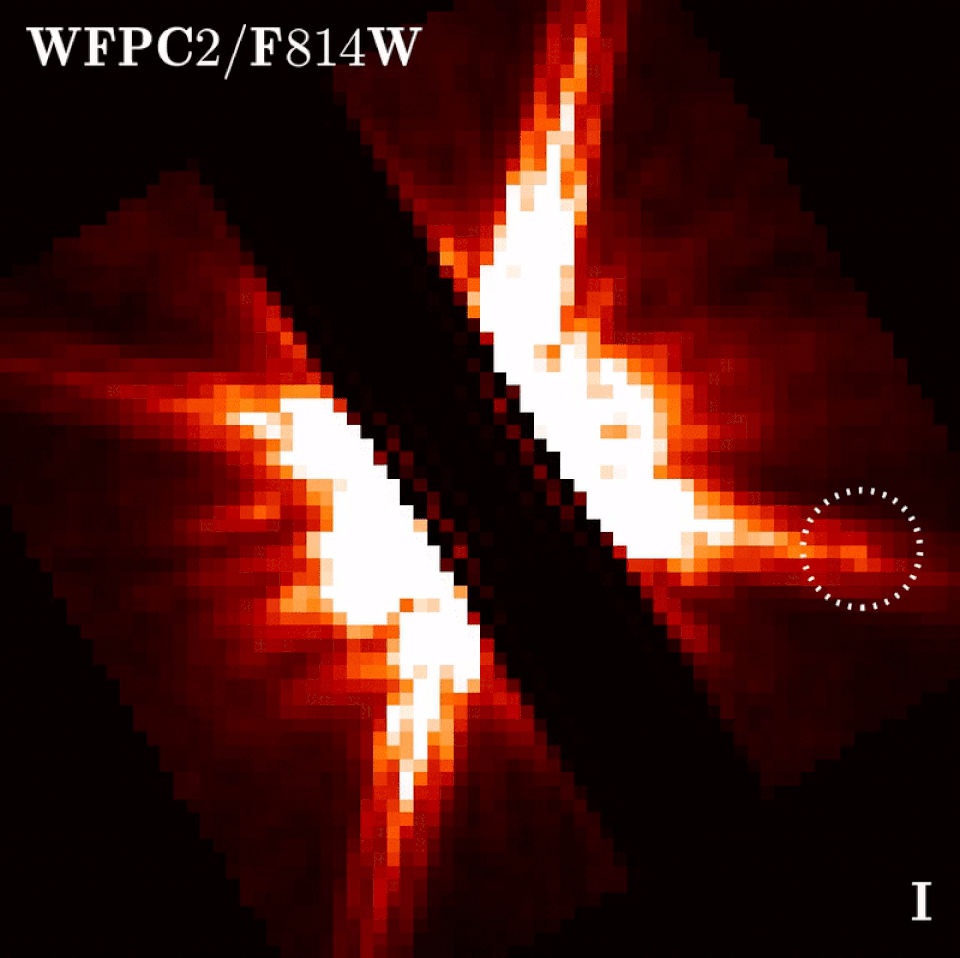 CS Chameleon photographed Hubble, and the characteristic diffraction rays, to put it mildly, impede the identification of a double companion. But by applying the appropriate techniques, you can subtract these rays, and see this companion
CS Chameleon photographed Hubble, and the characteristic diffraction rays, to put it mildly, impede the identification of a double companion. But by applying the appropriate techniques, you can subtract these rays, and see this companionIf it were a background object, many years ago it would not have been in the same place as it is now, thanks
to the star ’s
own motion across the sky. Therefore, this dim ball of light with high polarization really turned out to be a companion of CS Chameleon. What does this mean?
According to Ginsky himself :
The most interesting is that the companion light is highly polarized. This preferred direction of polarization usually appears when light scatters along its path. We suspect that the companion is surrounded by its own dust disk. The trick is that the disk blocks most of the world, so we can hardly determine the mass of the companion.
Interestingly, the data not only suggests that the companion has its own disc, but that this disc is not parallel to the disc of the main binary star!
 Infographics of the CS Chameleon CS double star and its surrounding double disk (left) with a recently opened companion (right). The companion is located more than 214 times farther from a binary star than the Earth from the Sun, but obviously belongs to this system. The entire system is located approximately 165 parsecs (538 light years) from Earth.
Infographics of the CS Chameleon CS double star and its surrounding double disk (left) with a recently opened companion (right). The companion is located more than 214 times farther from a binary star than the Earth from the Sun, but obviously belongs to this system. The entire system is located approximately 165 parsecs (538 light years) from Earth.To reproduce the data we receive, the disk must be located to us almost edge. Which is strange, since the disk of the Chameleon’s main binary system CS is tilted towards us somewhere between the “edge” and “plane” positions. We have seen this lack of alignment more than once - we have already encountered dust and non-parallel
binary and
ternary systems. But we first discovered a polarized companion outside one of these protoplanetary disks!
Since its dust disk blocks so much light, it is very difficult for us to determine the mass of a companion. Does he belong to the planets of the class of Jupiter? Super Jupiter? Or, according to the authors, is it a brown dwarf of small mass: an underdeveloped star?
The presence of a dust disk around a companion almost certainly means that, whatever he may be, in the future he will receive his own companions!
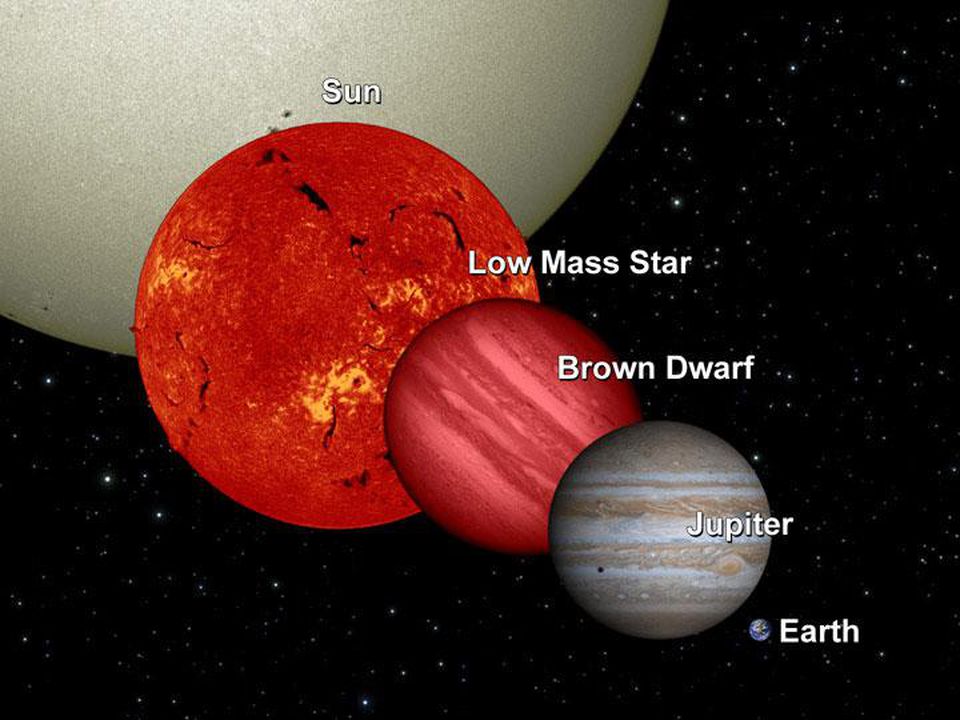 Brown dwarfs, from 13 to 80 masses of Jupiter, will turn deuterium + deuterium into helium-3 or tritium, and remain about the same size as Jupiter, only acquire a much larger mass. The current companion CS Chameleon can have a mass of from several Jupiter masses to 20 such masses. In the figure, the Sun is not given to scale; it would be many times larger.
Brown dwarfs, from 13 to 80 masses of Jupiter, will turn deuterium + deuterium into helium-3 or tritium, and remain about the same size as Jupiter, only acquire a much larger mass. The current companion CS Chameleon can have a mass of from several Jupiter masses to 20 such masses. In the figure, the Sun is not given to scale; it would be many times larger.We are not sure that we correctly estimate the age of the system at 2-3 million years, and we are not sure that it has already completed its formation. The SPHERE tool, available in the Very Large Telescope, has reached its limits in infrared astronomy, but if we go over long wavelengths and other observatories, we can find out. Therefore, the team plans follow-up observations with the
ALMA telescope.
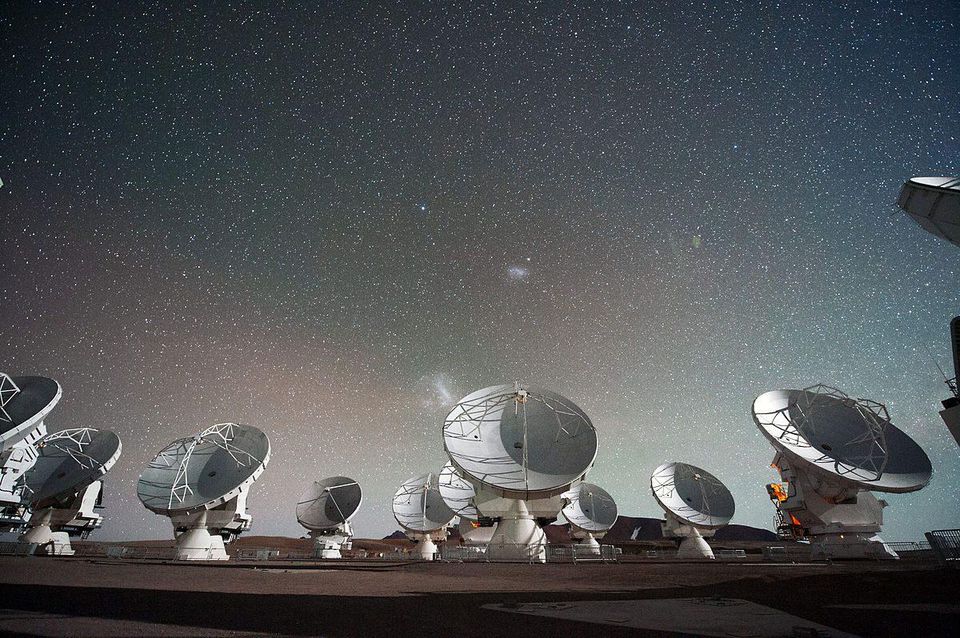 Atacama Large Millimeter submillimeter Array ( ALMA ) is one of the most powerful radio telescopes on Earth. They are able to measure long-wave signals of atoms, molecules and ions that are inaccessible to telescopes operating with shorter wavelengths, such as Hubble. They are also able to measure in detail the characteristics of protoplanetary systems that are not visible even to infrared telescopes.
Atacama Large Millimeter submillimeter Array ( ALMA ) is one of the most powerful radio telescopes on Earth. They are able to measure long-wave signals of atoms, molecules and ions that are inaccessible to telescopes operating with shorter wavelengths, such as Hubble. They are also able to measure in detail the characteristics of protoplanetary systems that are not visible even to infrared telescopes.When considering such systems, there is a whole heap of additional questions. Is the companion's mass increasing? Does the light emitted by it change in time? Are the main binary stars of the planet formed in the disk? Will the polarization percentage change over time? The main disk of a double star ends approximately at a distance equal to the distance from the Sun to the aphelion of Pluto, but the additional companion is at a distance ten times larger. And, as the authors conclude:
We found that the obtained set of observations best explains an extinct brown dwarf of small mass (≈ 20 masses of Jupiter) or a planet of large mass surrounded by a non-decaying disk.
It may turn out that for the first time we are observing the starry or planetary system in the process of formation: a version of Jupiter and Jupiter's moons on an enlarged scale. Receiving additional information on this particular system and on others similar to it, we embark on the path of an accurate understanding of how the stellar systems of this Universe are formed, developed and grow. Amazing time to look at the sky!